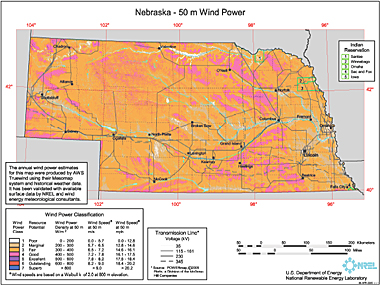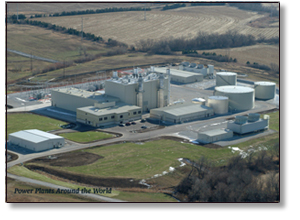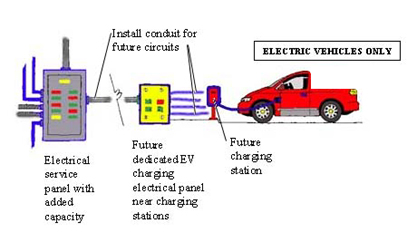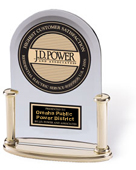News Bytes
An Update on America’s Energy Addiction
 The United States was once the world’s largest oil exporter, today we are the largest importer. According to the U.S. Department of Energy in a July 2006 report, between January and May of 2006, the nation imported 10.6 percent of its crude oil and refined petroleum products from the Persian Gulf. Collectively, 60 percent of the nation’s petroleum needs for the first five months of 2006 were met from imports. The top five foreign suppliers were: Canada, 10.5 %; Mexico, 7.4%; Venezuela, 7.1%; Saudi Arabia, 7.1% and Nigeria, 5.9%.
The United States was once the world’s largest oil exporter, today we are the largest importer. According to the U.S. Department of Energy in a July 2006 report, between January and May of 2006, the nation imported 10.6 percent of its crude oil and refined petroleum products from the Persian Gulf. Collectively, 60 percent of the nation’s petroleum needs for the first five months of 2006 were met from imports. The top five foreign suppliers were: Canada, 10.5 %; Mexico, 7.4%; Venezuela, 7.1%; Saudi Arabia, 7.1% and Nigeria, 5.9%.In the most recent month, July 2006, the American Petroleum Institute estimated that 67.2 percent of the nation’s petroleum came from imports, up from 65.5 percent in a year ago. Importing 60+ percent of the oil we need is about 13 million barrels of oil every day, at a cost of $300 billion dollars a year. Oil is already the single largest contributor to the nation’s trade deficit. America is on track to import 70 percent of our petroleum needs by 2025, if not sooner.

A new and growing dependency is refined petroleum products such as gasoline. According to the Energy Information Administration, the nation is importing 13 percent of the gasoline it uses, up from 11 percent in 2005 and up from less than 8 percent in 2000. America’s drivers use almost half the gasoline produced in the world each and every day.
And this just in: Refinery bottlenecks could prop up gasoline and diesel prices until 2010, according to oil industry officials. Oil executives and officials meeting in Vienna in mid-September 2006 said that refinery capacity shortages may continue until 2010, keeping oil prices high until then. Achieving increased capacity by 2010 depends on all 66 planned refineries being built and $300 billion being invested in other areas by 2015, officials said.
 27 State Survey...
27 State Survey...Ag Producers: Bioenergy in Next Farm Bill
Agricultural producers want to see the next federal farm bill address renewable energy issues as well as traditional concerns such as disaster relief and other "safety-net" provisions according to a new national survey, "The 2007 Farm Bill: U.S. Producer Preferences for Agricultural, Food and Public Policy," released in September 2006. The University of Nebraska-Lincoln conducted the survey of producers in 27 states in conjunction with the Farm Foundation.
University of Nebraska-Lincoln ag economist Brad Lubben, who coordinated the survey, said producers identified three fundamental policy areas as key goals for the new farm bill: renewable energy, small and beginning farm and ranch opportunities and food security.
New Energy-Efficiency Home and Vehicle Tax Credits Consumers who purchase fuel-efficient hybrid vehicles, make energy-efficient upgrades to their homes will be able to take advantage of valuable federal tax credits starting in 2006. Consumers who purchase fuel-efficient hybrid vehicles, make energy-efficient upgrades to their homes will be able to take advantage of valuable federal tax credits starting in 2006. |
As 2006 winds down, don’t overlook an array of tax credits for making energy efficient home improvements or purchasing gas stingy vehicles. There are a variety of resources that provide information on the various tax credits available.
One resource, the ENERGY STAR team at the U.S. Environmental Protection Agency, developed a series of fact sheets on tax credits in the Energy Policy Act of 2005:
- Consumer Tax Credits for Energy Efficiency
- Using Home Performance with ENERGY STAR to Take Advantage of Tax Credits for Residential Energy Efficiency
- Are You Ready to Take Advantage of the New Commercial Tax Incentives
 A new Web site from the Tax Incentives Assistance Project aims to help individuals and businesses cut their tax bills and energy bills through energy efficiency. |
Additional information on tax credits for energy improvements is available from several other sources:
 Forecasting Wind Speeds To Get Better
Forecasting Wind Speeds To Get BetterThe Municipal Energy Agency of Nebraska, also known as MEAN, received a $26,000 grant and $4,000 scholarship from the American Public Power Association to develop a wind energy forecasting module. With the grant, MEAN will be able to track wind velocity at two wind farms, one of which is in Kimball, Nebraska.
The ability to forecast loads accurately has financial implications, according to MEAN staff member John Krajewski. “Penalties for under scheduling energy to serve load because wind production is not meeting expectations can be extremely costly. These penalties can add a tremendous amount to the overall cost of a wind project,” said Krajewski.
Once the forecasting module is completed in the fall of 2006, it will be available to all American Public Power Association members for their use. The project is also being partially funded by Nebraska Municipal Power Pool’s Energy Research and Development Fund.
 LES' Salt Valley Generating Plant LES' Salt Valley Generating PlantPhotograph courtesy of Power Magazine |
Lincoln Electric System Rates in Lowest 10 Percent
For 19 straight years, Lincoln Electric System’s rates have ranked in the lowest ten percent in a nationwide study of 106 cities completed in July 2006. According to the survey, Lincoln Electric System customers who used 1,000 kilowatthours of electricity pay about $61, 39 percent less than the survey average of $98.
According to the utility, the average residential bill in Nebraska is $65. The survey found the highest residential rate was in New York City with $234 and the lowest was in Lexington, Kentucky at $55.
 Taking a Look...
Taking a Look...Nebraska Public Power District May Buy Electric Vehicles
The Columbus-based Nebraska Public Power District is considering buying several electric utility vehicles for use at power plants. The utility had the vehicles in Columbus in August 2006 to “test drive” the new electric technology being used. The utility expects to make a decision on the vehicles in the next few months.
The specialized trucks utilize 110 volt chargers that require 4-6 hours to re-charge. The vehicles cost between $17,000 and $20,000. Based on the utility’s analysis, the electricity used by the vehicles equals about 75 cents compared to the energy in a gallon of gasoline. “With the cost of gasoline as it is, these electric vehicles could be a smart exchange for the gas-powered trucks and vans we currently use,” Ron Asche, utility president said.
Omaha Public Power District Wins Top Service Award
 For six years straight, Omaha Public Power District customers have recognized the utility’s efforts to provide quality and
For six years straight, Omaha Public Power District customers have recognized the utility’s efforts to provide quality and  reliable service according to a survey by J.D. Power and Associates. The survey shows OPPD at the top of the medium-size utility category in the nation in overall customer satisfaction.
reliable service according to a survey by J.D. Power and Associates. The survey shows OPPD at the top of the medium-size utility category in the nation in overall customer satisfaction. The J.D. Power study evaluates how customers feel about their local utility company by assessing such factors as price and value, billing and payment, power quality and reliability, customer service and company image. Another issue that proved a key to this year’s rankings was effective customer communications. The satisfaction study is based on telephone interviews with residential customers of the 76 largest utilities in the continental United States.